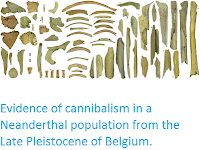Early Modern Humans migrating from Africa are known to have encountered and interbred with two Archaic Human populations, Neanderthals and Denisovans, with almost all non-African Humans carrying some DNA from these groups and most Africans carrying little if any. Previous studies have suggested that modern Eurasians have inherited about 2% of their DNA from Neanderthal ancestors, while Melanesians have about 5% Denisovan DNA.
In a paper published in the journal Cell on 22 March 2018, Sharon Browning of the Department of Biostatistics at the University of Washington, Brian Browning of the Division of Medical Genetics at the University of Washington, Ying Zhou, also of the Department of Biostatistics at the University of Washington, Serena Tucci of the Department of Ecology and Evolutionary Biology at Princeton University, and Joshua Akey of the Department of Ecology and Evolutionary Biology and the Lewis-Sigler Institute for Integrative Genomics at Princeton University, publish the results of a new study in which genomes from non-African populations from the 1000 Genomes Project were compared to the genomes of two Archaic Humans from the Altai Mountains of southern Siberia, one Denisovan and one Neanderthal, in order to better understand the genetic contribution of these two groups to non-African Modern Human groups.
All Humans, including Archaic populations such as Neanderthals and
Denisovans, share almost all of their DNA. In this context 'Neanderthal
DNA' or 'Devisovan DNA' refers to variable alleles found in the ancient
population, but not in modern African populations not thought to share
any genetic heritage since the ancestors of these groups left Africa in
the Middle Pleistocene. An allele is one of two or more different genes
that can occur at a
gene locus, for example different alleles for blue or brown eyes may be
found at
the gene locus for eye colour in Humans
Reconstruction of a Neanderthal Woman. Morten Jacobsen.
In line with previous studies, Browning et al. found that East Asian populations had a higher proportion of Neanderthal DNA than European populations, while the proportion of Neanderthal DNA in South Asians and Europeans was roughly similar, while the Papuan population had a significant proportion of Denisovan DNA. Modern Europeans were also shown to have a significantly higher proportion of Neanderthal DNA than modern West Africans (who have almost no Neanderthal DNA), while Americans have lower levels of Neanderthal DNA than Europeans (though this may be due to recent mixing with other population groups. Denisovan DNA was found at a higher level in East and South Asians than Europeans, with some European groups, such as Finns, having a higher proportion of Denisovan DNA than others. Native American populations also had some Denisovan DNA, though less than in South and East Asians.
Curiously modern East Asian populations seemed to carry Denisovan DNA from two sources, one closely related to the Altai Denisovan, and one more distantly related, whereas all Denisovan DNA in other populations, including Papuans, appeared to carry only DNA from the distantly related population. This suggests that East Asians went through an additional phase of interbreeding with Denisovans after their split from Papuans and South Asians, while Papuans may have had a second phase of interbreeding with the distantly related Denisovan population after their split from East and South Asians, or simply have derived from a subsection of that early population that had interbred with Denisovans more extensively.
Reconstruction of a Denisovan Man. John Baravo.
East Asians were shown to have an average of 30% more Neanderthal DNA than Europeans, though there was no suggestion that this came from more than one source. Browning et al. suggest that the most likely explanation for this is interbreeding between the ancestors of modern Europeans and other Modern Human populations with no admixture of Neanderthal DNA after their split from East Asians.
See also...
Follow Sciency Thoughts on
Facebook.








